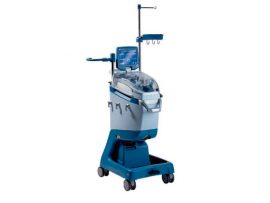Abstract Extracorporeal membrane oxygenation (ECMO) is a form of cardiopulmonary support associated with improved survival in severe respiratory failure and refractory cardiac arrest. Extracorporeal membrane oxygenation is highly specialized and..
Read MoreAbstract BACKGROUND: Extracorporeal membrane oxygenation (ECMO) is an effective measure for saving the lives of critically ill patients. Prompt identification of the risk factors for mortality among patients receiving ECMO and..
Read MoreAbstract Objectives The present study was designed to investigate the equivalence of two target activated clotting time (ACT) values with regard to packed red blood cell (PRBC) transfusion in patients..
Read MoreAbstract Cardiac arrest outcomes remain historically poor with survival to hospital discharge less than 2.2% in the UK (). Refractory cardiac arrest is characterized by a persistent loss of circulation..
Read MoreAbstract Background Vasoactive-inotropic score (VIS) has been previously utilized as one of the predictors in open heart procedures postoperatively, but its association with poor outcomes in patients who underwent coronary..
Read MoreAbstract To determine the optimal perfusion volume for the celiac artery (CA) and superior mesenteric artery (SMA) in a porcine model. Fifteen Yorkshire pigs (46.7 ± 5.2 kg) underwent selective CA and..
Read MoreAbstract Cardiovascular disease is responsible for of all deaths in Europe. Decades of research and investment have achieved impressive declines in overall cardiovascular disease mortality, yet this progress hides a persistent..
Read MoreAbstract Normothermic regional perfusion during controlled donation after circulatory death has emerged as a means to increase the number and viability of organs available for transplant. Because normothermic regional perfusion..
Read MoreAbstract Objectives The platelet trigger at which to transfuse platelets to prevent bleeding complications in patients supported with extracorporeal membrane oxygenation (ECMO) is unclear. We aimed to elucidate the association..
Read MoreAbstract Background Hyperlactatemia and acute kidney injury (AKI) represent significant perioperative complications in cardiac surgery. This study investigated their relationship by analyzing multiple lactate parameters during on-pump cardiac procedures. Methods..
Read MoreAbstract Background (ECMO) may be used to support critically ill patients before . The relationship between preoperative venoarterial and venovenous ECMO and their relationship with indications remain poorly elucidated. Methods This study..
Read MoreAbstract Background The identification, triage, and management of cardiogenic shock (CS) are complex and resource intensive, particularly given the recent surge in the use of temporary mechanical circulatory support (tMCS)..
Read MoreAbstract Aortic malperfusion occurs in a significant percentage of patients with acute , and causes , the clinical entity defined by end organ , in 10–33% of patients. Malperfusion syndrome can be rapidly..
Read MoreAbstract PurposeThe Modified Glasgow Prognostic Score is an inflammation-based index utilizing C-reactive protein and albumin levels. It has been investigated in various diseases such as cancer, heart failure, and myocardial..
Read MoreAbstract Background Congenital heart disease (CHD) that requires heart surgery is common. Severe postoperative pulmonary hypertension (PH) occurs in 2% of cardiac procedures and is associated with high morbidity and..
Read MoreAbstract Objectives After cardiac surgery, long aortic clamping times and extracorporeal circulation times are associated with worse outcomes. This study compares hemodynamic performance, myocardial metabolism, and ultrastructural preservation in rat..
Read MoreAbstract Normothermic regional perfusion (NRP) is a strategy of postmortem reperfusion with warm oxygenated blood of a portion of the body applied in donors undergoing circulatory determination of death (DCDDs)...
Read MoreAbstract Objectives: To evaluate the safety and efficacy of venovenous extracorporeal membrane oxygenation (ECMO) cannulation by nonsurgeon intensivists (critical care medicine intensivists [CCM]) compared with cardiothoracic surgeons (CTS). Design: Retrospective,..
Read MoreAbstract Activation of the alternative complement pathway by artificial extracorporeal surfaces is relevant to several clinical applications such as cardiac surgery with cardiopulmonary bypass (CPB), thoracic organ transplantation and hemodialysis...
Read MoreEn-bloc Heart–Liver Procurement 1. Exposure and Preparation The procedure begins with a midline sternotomy extended into a midline laparotomy, allowing simultaneous access to both the thoracic and abdominal cavities. The..
Read MoreAbstract Background Cardiac allotransplantation is the optimal treatment for end-stage heart failure. However, organ supply remains the principal issue affecting patients. Pediatric patients present unique challenges resulting in long wait-list..
Read MoreAbstract The challenging management of coagulation in cardiothoracic surgery requires a multifaceted approach. The use of pharmacological interventions such as tranexamic acid, heparin, and aprotinin minimizes bleeding but increases the..
Read MoreAbstract Blood compatibility, defined as a material’s ability to maintain blood flow without inducing coagulation or hemolysis, was investigated through surface roughness optimization in blood pump flow channels. This study..
Read MoreAbstract Background Postoperative infectious pneumonia (PIP) is a common and serious complication following cardiothoracic surgery, including coronary artery bypass grafting (CABG), valve interventions, and thoracic oncologic procedures. It is associated..
Read MoreAbstract Transcatheter aortic valve implantation (TAVI) has revolutionized the treatment of severe aortic stenosis in high-risk patients, offering a minimally invasive alternative to open-heart surgery. However, complications such as hemodynamic..
Read MoreAbstract Background Pulmonary endarterectomy (PEA) using deep hypothermic circulatory arrest (DHCA) and cardiopulmonary bypass (CPB) is the preferred treatment for chronic thromboembolic pulmonary hypertension (CTEPH). Crystalloid priming solutions cause hemodilution..
Read MoreAbstract Globally, cardiovascular diseases (CVDs) are the major leading cause of death. Medical literature shows an association between CVDs and depressive symptoms, anxiety, low social support, and optimism. Also, cardiac..
Read MoreAbstract Intraoperative cell salvage (ICS) is a blood conservation technique utilized in major surgery, yet its application in oncologic procedures remains debated. Concerns persist about the theoretical risk of metastasis..
Read MoreAbstract Thrombosis in extracorporeal membrane oxygenation (ECMO) circuit components remains a challenge. Besides blood state and surface properties, flow plays a critical role in hemostasis. In this work, we aimed..
Read MoreAbstract There are limited data on the use of extracorporeal membrane oxygenation (ECMO) in high-risk pulmonary embolism (PE) patients. We analyzed the use of ECMO in high-risk PE patients (defined..
Read More


















